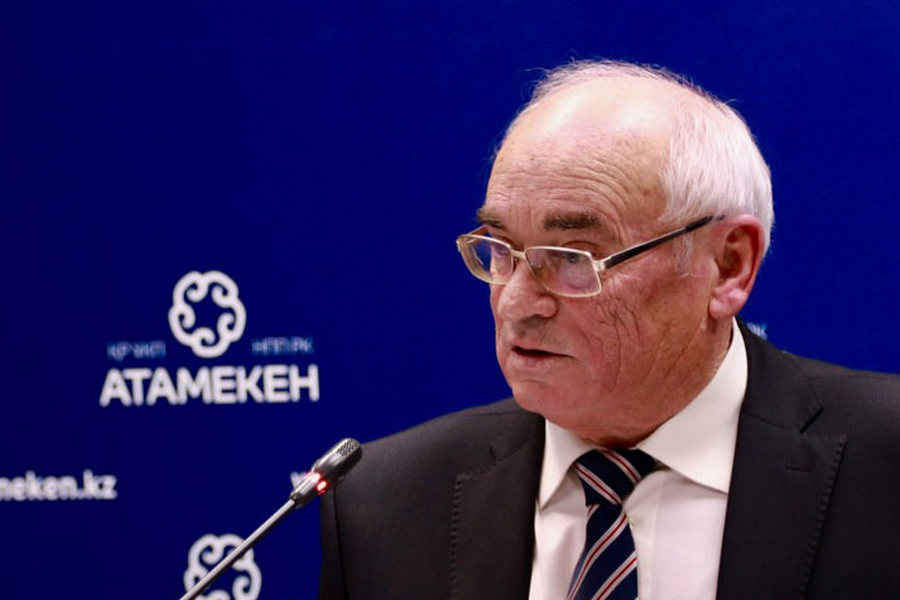Kazakh Deputy Prosecutor General Zhakyp ASANOV:
KAZAKH PENITENTIARY SYSTEM NEEDS DRASTIC CHANGES TO REDUCE THE NUMBER OF PRISON POPULATION

Kazakhstan is taking all necessary measures to reduce the prison population. To this end, the republic has launched prison reforms. Deputy Prosecutor General Zhakyp ASANOV told Interfax-Kazakhstan in an interview about the results achieved to date and the prospects for the reforms.
- Mr Asanov, will you please give an update on the current situation in the prisons of Kazakhstan? Has the number of prison population decreased in the past few years?
- The number of prison population in the republic is on decrease. For instance, in 2010 we had 62,997 inmates in the prisons or 395 incarcerated per 100,000 population.
In 2011, the number decreased to 55,552 prisoners or 344 incarcerated.
The tendency continued in 2012 when Kazakhstan had 48,684 inmates, ranking 35th by prison population in the world.
In 2013, Kazakhstan's ranking further improved to make 36th, with 296 incarcerated per 100,000 population.
- Has the number of non-guilty verdicts rendered by courts increased? What are the alternatives to imprisonment and arrest?
- I would like to note that in the first quarter 2014 only 32% of all verdicts were prison sentences, which was the lowest rate in the history of Kazakhstan, including the Soviet era. Previously, the prison sentences rate was usually above 40-45%.
For instance, 44 people were acquitted in 2010, 63 in 2011, 55 in 2012, 46 in 2013 and 12 people in the first quarter 2014.
In January-March 2014 the criminal courts heard 8,500 cases or 500 cases fewer that in the same period of 2013. This year, we expect an increase in the number of criminal cases as there has been no amnesty and the laws have not been decriminalized. Furthermore, the number of crime rate has soared three times in the last three years after tougher procedures for crime registration were introduced.
However, this year the number of cases heard in the courts has decreased by 6% because we have introduced additional reconciliation mechanisms. Historically, the police used to send most of the criminal cases, which could have been closed through reconciliation, to court. What has changed since the new reconciliation mechanisms came into force?
For instance, in 2012 the prosecutors closed 13,500 cases through reconciliation, the number of such cases jumping threefold in 2013 to reach 40,000.
In the first quarter 2014, the number of cases that were ended through reconciliation doubled compared the same period last year.
On the one hand, we have taken some of the burden from the courts so that they could focus on more complicated cases. On the other hand, we are taking measure to make sure that reconciliation is exclusively voluntary but not forced by investigators or prosecutors.
The prison population in Kazakhstan has decreased after we introduced alternatives to criminal prosecution. More often, the courts now allow parole applications, an increase to 40% from 45%, or replace the remaining prison terms with milder punishment, an increase to 55% from 42%. More often, the suspects are now released on bail instead of arrest.
The number of arrests declined 4.5% in the first quarter of this year, while the bail accounted for 12% of all cases.
As many as 8,101 people were sentenced to prison terms in 2013 or 32.8% of all decisions rendered by criminal courts compared to 5,608 prison sentences or 25% in 2012.
We expect the prison population to decrease further after the new Criminal Code comes into effect in early 2015.
- What is the status of the prison reform in Kazakhstan?
- In the last twenty years, Kazakhstan has seen seven amnesty campaigns, significantly humanized its criminal legislation, introduced alternatives to criminal prosecution and milder punishment for some crimes.
In order to decrease the prison population the republic adopted a number of national programs--including "Probation and Electronic Bracelets Instead of Prisons," "Reconciliation in Criminal and Civil Proceedings," "Ten Measures to Reduce Prison Population." The latter was developed together with Penal Reform International (PRI), non-government organizations of Kazakhstan, law enforcement bodies and international experts. This document deals with the roadblocks that prevent the prison population from shrinking.
Kazakhstan has developed new codes: criminal, criminal procedural and penal. There is also a new version of the Civil Procedural Code that will be completed soon.
The republic adopted a number of bylaws and special programs aimed to decrease the prison population.
- What were the reasons behinds the penal reform in Kazakhstan?
- First, we needed to reduce the prison population. According to the international standards, the criminal justice system and prison management can only be efficient if the prison rate is below 150 incarcerated per 100,000 population.
Second, there were economic reasons. Kazakhstan's expenditures on the penitentiary system have been growing over the past years. For instance, in the last four years the prison budget has soared 54%. This year’s budget is set at 47.5 billion tenge. One prison inmate cost the government already 613,000 tenge in 2013 compared to 580,000 tenge in 2012.
There was a case in the North Kazakhstan Region when a woman was sentenced to three years in prison for stealing her neighbor's belongings worth 10,000 tenge. In the end, the government spent 1.7 million tenge on her while she served time in prison.
- Mr Asanov, how important do you think the role of the probation practice will be?
- Kazakhstan pins great hopes on the probation system. I would like to remind you that Kazakhstan adopted amendments introducing probation on February 15, 2012.
The probation practices were discussed in detail at the First Forum of Penal Reforms in Astana in March last year. Nearly all recommendations voiced at the Forum were incorporated in the new Criminal Procedural Code.
The new Code cancels the criminal penal inspectorate but introduces the so-called probation services instead. Probation will apply not only to convicts on parole but also to those who went on trial on administrative charges not punishable with prison terms.
- Some people express concerns that the milder punishment for crimes may lead to a rise in crime rate, because the criminals, who are usually isolated from the law obedient citizens, will be set free.
- I, personally, do not share such fears. Our plan to reduce the prison population does not imply that those who committed serious crimes will not go to prison. This means that we are not going to let murderers, sadists or cannibals go free and pose a threat to the ordinary people. The mitigation measures must not be in any way detrimental to public order, citizens' rights and public safety. Therefore, our proposed measures aimed at reduction of prison population are very specific. Moreover, these measures will be directed at the causes of crimes but not consequences.
- To what extend the reforms will change the prison conditions?
- The new Criminal Procedural Code contains some new articles.
All prisons will be categorized depending on the degree of threat the convicts may pose to public safety: minimum, medium, medium juvenile, major, serious, very serious and mixed. The prisons will now be required to offer cells for inmates to live in.
The legal amendments also provide for better protection of the convicts' rights, which will include requirement for better living conditions: larger space per inmate, rooms for disabled inmates supplied with specialized equipment, use of telecommunication means so that the prisoners could keep in touch with their families as well as creating jobs for inmates.
- Can you comment on prison reforms in the neighboring countries? Are they a success? Do you think the prison conditions in these countries are improving?
- I must tell that the prison reforms in all post-Soviet states are pretty much the same, none of them is worth mentioning here.
As far as the Western Europe is concerned, they use electronic equipment like ankle bracelets and others to follow the movements of convicts on parole. They also widely use alternative mechanisms, such as reconciliation, release on parole, and post-penitentiary probation programs. I would like to note that we learn a lot from the West European best practices.
Many international experts, including Baroness Vivien Stern who is one of the PRI founders, recognize that the prison reforms ongoing in Kazakhstan are positive and quite effective.
Unlike other countries where amnesty campaigns--which usually have a short-term effect--are the only measure to reduce prison population, Kazakhstan is taking an integrated approach towards reduction of prison population.
- Thank you for your time!
May, 2014
© 2025 Interfax-Kazakhstan news agency
Copying and use of these materials without reference to the source is prohibited
Archive





